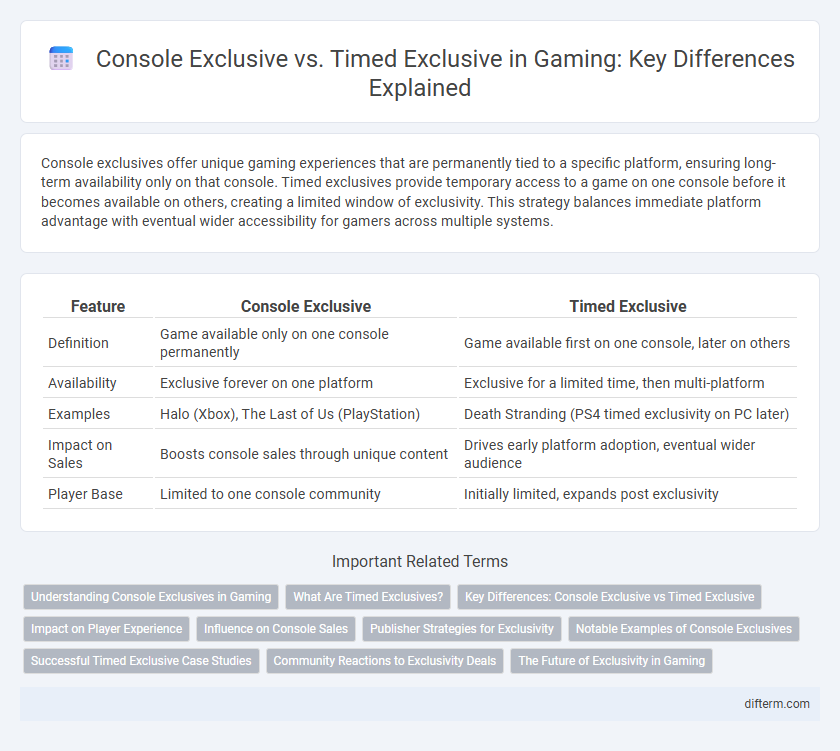Console exclusives offer unique gaming experiences that are permanently tied to a specific platform, ensuring long-term availability only on that console. Timed exclusives provide temporary access to a game on one console before it becomes available on others, creating a limited window of exclusivity. This strategy balances immediate platform advantage with eventual wider accessibility for gamers across multiple systems.
Table of Comparison
| Feature | Console Exclusive | Timed Exclusive |
|---|---|---|
| Definition | Game available only on one console permanently | Game available first on one console, later on others |
| Availability | Exclusive forever on one platform | Exclusive for a limited time, then multi-platform |
| Examples | Halo (Xbox), The Last of Us (PlayStation) | Death Stranding (PS4 timed exclusivity on PC later) |
| Impact on Sales | Boosts console sales through unique content | Drives early platform adoption, eventual wider audience |
| Player Base | Limited to one console community | Initially limited, expands post exclusivity |
Understanding Console Exclusives in Gaming
Console exclusives are games available only on a specific gaming platform, driving console sales and enhancing brand loyalty. Timed exclusives release on one console first before launching on other platforms after a set period, maximizing initial platform engagement while eventually expanding the player base. Understanding these categories helps gamers anticipate game availability and make informed purchasing decisions based on exclusive content and release timing.
What Are Timed Exclusives?
Timed exclusives are video games available on a specific console for a limited period before launching on other platforms, designed to boost initial sales and attract players to the console. Unlike permanent console exclusives, timed exclusives create a temporary advantage that leverages early access and marketing buzz. This strategy often involves collaboration between developers and console manufacturers to maximize exposure and revenue during the exclusivity window.
Key Differences: Console Exclusive vs Timed Exclusive
Console exclusive games remain available solely on a specific gaming platform indefinitely, ensuring that only users of that console can access the title. Timed exclusive games appear on one platform first but become available on others after a predetermined period, allowing broader accessibility over time. The key distinction lies in availability duration and platform restriction, affecting consumer choice and developer marketing strategies.
Impact on Player Experience
Console exclusives often foster a tailored gaming experience with optimized performance and unique content, enhancing immersion for players on that platform. Timed exclusives can create anticipation and broaden eventual accessibility, but may cause frustration due to delayed availability on other systems. Both models impact player engagement by influencing platform loyalty and gameplay variety.
Influence on Console Sales
Console exclusives directly boost hardware sales by offering unique, must-play titles unavailable elsewhere, significantly attracting gamers to purchase that specific platform. Timed exclusives create short-term sales spikes by granting early access, but their impact on long-term console sales is less pronounced compared to true exclusives. Both strategies leverage game availability to influence consumer loyalty and drive market competition.
Publisher Strategies for Exclusivity
Publishers deploy console exclusives to build long-term brand loyalty and maximize hardware sales for a specific platform, leveraging unique titles that drive console demand. Timed exclusives serve as strategic tools to generate early enthusiasm and temporary competitive advantages, allowing publishers to reach multiple audiences by eventually launching on additional platforms. This phased release approach balances initial market capture with broader monetization opportunities, optimizing revenue streams across various consumer bases.
Notable Examples of Console Exclusives
Console exclusives like "The Last of Us Part II" on PlayStation 4 and "Halo Infinite" on Xbox Series X showcase titles available solely on a single platform, enhancing brand loyalty and driving hardware sales. Timed exclusives such as "Cyberpunk 2077" on Xbox Series X initially restricted availability on other consoles for a limited period, generating anticipation across competing platforms. These exclusivity strategies impact player communities and the competitive landscape by influencing game access and platform preference.
Successful Timed Exclusive Case Studies
Successful timed exclusive games like "Death Stranding" on PS4 and "Halo Infinite" on Xbox Series X showcase how limited platform availability can boost console sales and amplify marketing impact. These titles leverage early access to generate hype and attract a dedicated player base, driving engagement before launching on other platforms. Timed exclusivity strategically maximizes revenue and exposure while maintaining broader audience reach over time.
Community Reactions to Exclusivity Deals
Community reactions to console exclusive versus timed exclusive gaming deals often highlight frustration over limited access and platform restrictions. Console exclusives create strong brand loyalty but can divide the player base, while timed exclusives prompt impatience and skepticism about future availability. Gamers frequently voice their concerns on social media and forums, emphasizing the impact on multiplayer experiences and overall community cohesion.
The Future of Exclusivity in Gaming
Console exclusives continue to shape platform identity by offering unique gaming experiences unavailable elsewhere, driving hardware sales and fostering dedicated fan bases. Timed exclusives provide strategic windows for cross-platform titles to maximize revenue while maintaining initial platform buzz. Emerging trends suggest that hybrid exclusivity models and subscription services will redefine access and competition in the gaming industry's future.
console exclusive vs timed exclusive Infographic

 difterm.com
difterm.com